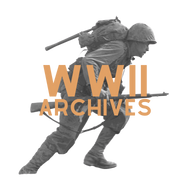Normandy landings
From WWII Archives
The Normandy landings (codenamed by the Allies Operation Neptune) were a set of airborne drops and amphibious landings that the Allied powers conducted against Nazi occupied Normandy beginning 6 June 1944. The objective was to open a new front in Nazi occupied Western Europe against Nazi Germany.
The Normandy landings were the landing operations and associated airborne operations on Tuesday, 6 June 1944 of the Allied invasion of Normandy in Operation Overlord during World War II. Codenamed Operation Neptune and often referred to as D-Day, it was the largest seaborne invasion in history. The operation began the liberation of France (and later western Europe) and laid the foundations of the Allied victory on the Western Front.
Background
Prelude
30 May
Rundstedt
3 June
Approx. 0130
Half a dozen teams of the OSS consisting of around 2 US soldiers (trained with operating signal devices), each accompanied with three British commandos for security, were flown into France with the objective of marking the Drop Zones which will then be later used by pathfinders to come in and bring more extensive marking equipment[1].
4 June
5 June
Operation Neptune
5 June
5 to 6 June
During the night of 5 to 6 June, Operations Taxable, Glimmer, and Titanic were conducted under Operation Bodyguard in deception of the German forces. Taxable was an operation where dummy parachutists were dropped near Boulogne, while also thousands of metal strips were dropped in order to create a radar screen near Pas-de-Calais in order to deceive the Germans into thinking that there is a large invasion convoy on its way towards there. For Titanic, two parachute teams of about a dozen airborne troops each were dropped near Isigny-sur-Mer to create the illusion for the Germans that this was a major airborne landing operation. Lastly, Glimmer was a air attack on fortifications in the Pas-de-Calais[2].
6 June
After 0100
After around 0100, the landing troops, mainly US troops, began receiving generous breakfasts, and then began gathering and putting their equipment on[3].
0130
0300
The 915th Infantry Regiment was sent near Isigny to counter the "threatening airborne attack" that was created by Operation Titanic, which diverted it away from the real allied attacks[4].
Approx. 0400
The troops getting ready to go off to land were called to assemble on their ship deck. They climbed down the scramble nets into each's landing craft. The landing craft would then join others and circle around. Many soldiers then began to regret their breakfast, as they became seasick, and started vomiting in their helmets, on the floor, and over the side[3].
Beginning of the landings
During the early morning hours when the sun was becoming visible, the Allied battleships opened up with their 14 inch guns. The destroyers and cruisers would soon follow in doing so. Since the dawn was bright enough, the Germans could see the invasion fleet.
0631
0635
The landings at Omaha begin[5].
The second wave at Utah begins
15:55
At 16:55, Adolf Hitler issued an order to Seventh Army headquarters. The order went as follows[6]:
16:55 hours. June 6, 1944
Chief of Staff Western Command emphasized the desire of the Supreme
Command to have the enemy in the bridgehead annihilated by the evening of
June 6 since there exists the danger of additional sea- and airborne landings
for support . . . The bridgehead must be cleaned up by not later than tonight.
2400
Aftermath
Citations
- ↑ Ford, Ken; Zaloga, Steven J (2009). Overlord : the D-Day landings. Oxford. p. 132.
- ↑ "Operation Bodyguard". WWII Archives. 28 November 2022.
- ↑ 3.0 3.1 Beevor, Antony (2014). The Second World War. p. 698.
- ↑ "Operation Titanic". WWII Archives. 28 November 2022.
- ↑ "D-Day timeline". D-Day and Battle of Normandy Encyclopedia.
- ↑ William Shirer, Rise and Fall of the Third Reich, p.1038, https://archive.org/details/risefallofthirdr50edshir_k3e0/page/1038/mode/2up
Bibliography
Shirer, William. Rise and Fall of the Third Reich.
Rives, Tim (2014). ""OK, We'll Go": Just What Did Ike Say When He Launched The D-day Invasion 70 Years Ago?" (PDF). National Archives and Records Administration. Retrieved 20 November 2022.
Lynch, Angela (27 May 2016). "WHAT, EXACTLY, DID IKE SAY TO LAUNCH THE INVASION?". National D-Day memorial.
Eisenhower, Dwight D. (1948). Crusade In Europe (1st ed.). William Heinemann Limited.
Hparkins (5 June 2014). "What did Ike say to launch the D-Day invasion?". Pieces of History.
"Cornelius Ryan longest day collection".
Beevor, Antony (2004). D-DAY: The Battle for Normandy. Viking. ISBN 978-0-670-02119-2.
Beevor, Antony (2014). The Second World War (2nd ed.). Weidenfeld & Nicolson. ISBN 978-1-7802-2564-7.
Wilmot, Chester (1956). The Struggle for Europe. Richard Clay and Company.
Contributors: Paul Sidle
